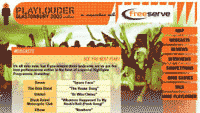Internet broadcasting


Tornado Productions webcast the Glastonbury Music Festival 2002 in conjunction with music Web site PlayLouder and Internet Service Provider Freeserve. The webcast was made available at two bitrates, one for 56kb/s modems and below, and one broadband for 56kb/s to 240kb/s.
Webcasting, or broadcasting over the Internet, emerged as a natural extension of text and image transfer. However, because the rate of transfer (bitrate) was exceptionally restrictive — 9600 baud being a common modem speed in 1992 — alternative compression methods had to be developed to deliver video and audio without unrealistic download times, and in particular to deliver live transmissions. Since then, stunning improvements have been made in compression techniques, and it is now commonplace to deliver audio and video webcasts for a range of connection speeds, ranging from 28kb/s modems to ADSL and LANs.
Webcasting vs. streaming
Webcasting is a general term that describes the transfer of audio or video over the Internet. This is usually in the form of a stream, which is the real-time transfer of a file from a server to a client machine at a rate that is matched to the available bandwidth. The terms streaming media and webcasting are often interchanged, but streaming specifically refers to the technology of real-time transmission. Webcasting is often used to describe a live event, but it is more correctly a broader term used to describe any transmission of video or audio, whether live or on-demand.
The concept of streaming in terms of matching the speed of transmission to the available reception speed is relevant to webcasting from three perspectives: quality, scale and costs. First, it enables control over the quality of the end-user experience. Second, it allows detailed control and bandwidth management from distribution servers across networks. This is crucial when dealing with sizeable concur-rency, such as a music festival, where the network may become saturated at any number of points and may be out of the control of any one network.
Finally, streaming is important in managing the cost of transmission. By controlling the outbound bandwidth, costs can be tightly managed, capacity planned and the resilience of systems increased.
Webcasting live events
The professional video industry's #1 source for news, trends and product and tech information. Sign up below.
To illustrate this, Tornado Productions webcast the Glastonbury Music Festival 2002 in conjunction with music Web site PlayLouder and Internet Service Provider Freeserve. As is still the case with many webcast productions, approval and contracts were agreed within only a few weeks of the event, adding significant pressure to the pre-production process.
Rights were cleared for a limited selection of artists from the main and pyramid stages for live, delayed live and on-demand presentation, and the performances were either webcast live, or recorded and then rescheduled to be played out at specific times via the PlayLouder Web site. The management of the Web audience in this manner was effective because it allowed the clustering of particular performances within a set time frame and the coordination with other Web activities such as chat rooms.
The webcast was made available at two bitrates, namely one narrowband for 56kb/s modems and below, and one broadband for 56kb/s to 240kb/s, and delivered from a load-balanced server farm at Freeserve’s main data facility. The streams were encoded in Windows Media 7 format, and multiple encoders were used to optimize the quality of the streams. The live streaming encoding was dealt with independently of the encoding for on-demand files in order to allow additional post-processing of the on-demand files to increase the quality. Separate encoders were used for the narrowband and live encoding.
After each day’s playout was complete, a full archive was made available on-demand for those who were unable to watch the live stream or who wanted replays. Finally, after the festival, a highlights package was made available on-demand for one month.
The webcasts received more than 70,000 views over the three festival days and a further 240,000 views over the following month for the archives.
In terms of what is possible, Glastonbury was a fairly straightforward event-based webcast that employed many of the same techniques as broadcasting. However, the potential for fully integrating Web technologies with video and audio production techniques has still to be fully exploited.
The true power of webcasting
Another example is taken from the development of an interactive video presentation with the new London-based art gallery, the Tate Modern. Working with more than 100 hours of pre-recorded interviews and lectures that were originally presented as a simple archive list, an integrated presentation format was developed. This combines a number of emerging technologies with a strong narrative-based aesthetic.
First, the videos were broken down into shorter, editorially book-marked clips. Second, the clips were ingested using automated voice transcription techniques and wrapped into an intelligent search engine. This technique allows the spoken word to be searched in exactly the same manner as a Web search engine, but returns the timecode of the video with a text excerpt as the results. Clicking on the results updates the whole presentation to the exact point in the video where the words were spoken. Finally, working with the Tate curator, pre-defined context-based searches were created to fully illustrate the natural language and context search capabilities of the system.
This type of integration combines strong graphic design, Web navigation, video search and video streaming into a presentation that is unique to the Web. The combined files and technology are unsuitable even for CD-ROM presentation, so this example serves to illustrate how the Web is evolving.
Gavin Starks is the CEO of Tornado Productions and the European Chair of the International Webcasting Association (IWA).
